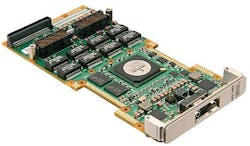XMC Gigabit Ethernet switch for military embedded systems introduced by Curtiss-Wright
ASHBURN, Va., 8 June 2012. Curtiss-Wright Controls Defense Solutions in Ashburn, Va., is introducing the XMC-651 managed Express Mezzanine Card (XMC) Gigabit Ethernet switch for embedded computing applications in military embedded systems. The 12-port XMC-651 can be mounted on a VPX or VME module supporting the XMC mezzanine standard.
The 651 mezzanine module requires no additional chassis slot to deploy. The module also is available in a PMC mezzanine configuration (PMC-651) that provides as many as eight ports of managed Gigabit Ethernet switching.
The XMC-651 supports full line-rate non-blocked Ethernet switching and the in-field management of networking features including VLANs, multicast, and quality of service. The module is available in air- and conduction-cooled variants and consumes less than 7.5 Watts of power with all 12 ports active.
The XMC-651 implements Ethernet switching functions via Broadcom 10th generation switching technology. Eight of the module's ports support 10/100/1000Base-T with auto-negotiation. An additional four ports support SerDes (1000Base-BX) Gigabit Ethernet.
Related stories
Curtiss-Wright Controls Defense Solutions releases dual LED backlit version of AVDU-2655 Multi-Function Display for NVG applications
Curtiss-Wright Controls Defense Solutions introduces rugged video switching, recording & distribution solution
Curtiss-Wright Controls VPX3-685 router begins common criteria certification.
The XMC-651 implements Layer-2 Ethernet switching with full wire-speed performance on all ports and features an 8K entry MAC address table, with automatic learning, advanced flow-control and head of line blocking prevention.
For more information contact Curtiss-Wright Controls Defense Solutions online at www.cwcdefense.com.
Follow Military & Aerospace Electronics and Avionics Intelligence news updates on Twitter

